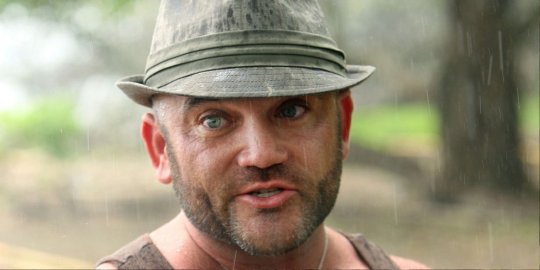#they will overcome the separation of teams to still stunt on everyone else together
Explore tagged Tumblr posts
Text
has someone checked on helmut marko? he might be lost in a flower shop somewhere picking out 500 gratitude bouquets for charles leclerc after another stunning assist to rbr
#charles leclerc#helmut marko#thinking about charles scheming to let checo by him in Vegas last year to try to help him keep ahead of the mercs to save the p2#obv last race#max indirectly/directly helping this race to hold back lando too#I see the lestappen teammate vision#they will overcome the separation of teams to still stunt on everyone else together
337 notes
·
View notes
Text
Izuku and Shigaraki: The Parallels Between a Hero and a Villain

To me, one of the most important features of a villain is how they reflect the hero. Either by taking an aspect of the character and embodying it, such as with Batman and Scarecrow, or by being the exact opposite of that character, like with Jonathan Joestar and Dio Brando. For a time, I never thought that such a relationship was shared between Izuku and Shigiraki. But after thinking about it for a time, I realized that they had more connections then I thought.
Abilities
-Both Izuku and Shigaraki’s Quirks are very destructive and hard to control. While Shigaraki literally destroys everything he touches, Izuku is consistently harming himself with his Quirk. This dichotomy could reflect the self-sacrificial role of a hero and the destructive nature of a villain respectively.
-Both Izuku and Shigaraki are fiercely intelligent. While Shigaraki is more of a long term planner, able to play the patience game for the right moment. Izuku is more of an in the moment planner, more often then not just trying to save anyone he can. This parallel could mirror the long term thought process often associated with villains and short term planning often seen with heroes.
-Both of Izuku’s and Shigaraki are astoundingly durable. Izuku, despite constantly breaking his bones and tearing up his tendon, still stands and fights. Shigaraki, even after being through beaten and shot time after time, always manages to come back. This could be seen as incorporating resilient nature of good and evil, one always always fighting on while the other always returns.
Personality
-Even though they are rather different, there are some smaller traits that connect these too. Both Izuku and Shigaraki have compulsive habits, Shigaraki with his neck scratching and Izuku with his constant mumblings. Both Izuku and Shigaraki could be seen as childish. Izuku for his endless admiration of heroes and Shigaraki with his volatile temper.
-Izuku is a rather meek boy, who, in spite of all of his accomplishment as a first year student, still lacks self-confidence. Shigaraki, who seems to fail at nearly everything he does, loves to declare his genius and superiority over everyone else. This could be the result of, even after fighting off several villains and proving himself a capable student, get repremanded for his actions. And that Shigaraki, even after he failed at the U.S.J. Incident, the Hosu Incident, and the Hideout Raid, is still forgiven and proped up by All For One.
-Both Izuku and Shigaraki have dealt with many hardships over the years. Izuku has faced a life of bullying and crushed dreams and Shrigaraki a life of bitterness and resent to the society he blames for his problems. What ultimately separates these two is how they deal with these trials. Izuku takes all the hardships life has thrown at him and either adapted to the hardship or even go as a far as making it a part of his own identity. Such as taking the insult constantly through at him and making it the name of a hero. Shigaraki instead gets angry at whatever and loses all his composure.
Healthy and Unhealthy
-Both Izuku and Shigaraki are nerds. They both have a deep love for something that is usually considered geeky, with Izuku’s love being for heroics and Shigaraki’s for video games. Izuku is more of an otaku, and uses his love to grow, develop, and keeps it at an appropriate level. Shigaraki is more of hikikomori, a total socially deprived recluse.
-Both Izuku and Shigaraki have a borderline obsessive love for their respective mentors. Both of which are pinnacles of their superpowered craft that dug them up from their lowest point. But while Izuku idealizes All Might, he still tries to forge his own path. Shigaraki seem more to worship All For One,
-Both Izuku and Shigaraki have been given power that isn’t their own, Izuku with “One For All” and Shigaraki’s patronage of All For One. The main difference is how they got them. Izuku had to earn the power he got. Even after that he still had to work and suffer to get where he is now. Shigaraki got the power not through any noteworthy traits of his own, but through just being related to someone that was important to All Might.
Relationships
-While the set up between the two mentor-student relationships are similar, how they are executed are very different. While Izuku hold a great amount of respect and admiration for All Might, it is still a healthy student teacher relationship. The relationship between All For One and Shigaraki seems more like master and elevated servant.
-Both Izuku and Shigaraki have a well developed, close group of allies. Izuku worked to gain the trust and admiration which resulted in a close netwrok of friend and allies. Shigaraki has cobbled together a barely coherent team of misfits whose entire cohesion is hanging by a thread. Again, while Izuku earned those relationship, they were merely given to Shigaraki.
-How they treat their allies is also very distinct. While Shigaraki treats them more like pawns, Izuku treats everyone around him as valuable friend and ally. Izuku even treats Bakugou, a guy who has consistently abused him through out his life, better then Shigaraki treats Kurogiri, his most valuable comrade.
Worldview
-Izuku is someone who is very driven. From the moment the reader meets him, the story makes it clear that he is someone is very determined. Even after his dreams are crushed, he doesn't give up the hope he could be a hero and continues to strive forward. Shigaraki honestly struggles to find any real meaning in what he does. Even his role as a villain is something that was just given to him by All For One.
-Both have been stunted by a society built off the backs of heroes. Izuku, in spite all his dreams of being a hero is helping people, is told he will never be a hero because he lacks a Quirk. Shigaraki was ignored in favor of letting the heroes do their job. While Izuku still strives to be a hero despite the zero percent he has of being a hero, Shigaraki seeks to destroy every part of that society.
-Both of them think they are doing what is right. While Izuku believes that keeping the status quo of heroes using their powers to save people, Shigaraki finds that such system is a crutch that makes people careless. But even in Shigaraki’s case, that in of itself may just be a kind of weak justification for what he does.
The Easy Way and The Right Way
What ultimately separates these two is what ultimately separates all heroes and villains: The Easy Way and The Right Way. It is easy to use the amazing gifts someone has gotten for selfish desires. It is hard to use those gifts to help other people. It was hard for Izuku to overcome all of those broken bones. It was hard for Izuku to grow beyond years of self-doubt. It was hard for Izuku to become a hero. It was easy that Shigaraki got angry and lashed out. It was easy that Shigaraki blame everything else for his problems and short comings. It was easy for Shigaraki to become a villain.
#My Hero Academia#Not Quirks#Midoriya Izuku#Deku#Tomura Shigaraki#All Might#All for One#Toshinori Yagi#Event#MHA Meta
281 notes
·
View notes
Text
Ctec503final Index post
Eden Pilbrow - Student ID no. 16947308
Team - Storm
Artifact - Storm Window
This isn’t all of the posts I have done but I think these are the most important ones showing my process through this entire semester. More can be found with the #ctec503movement and others sprinkled in there posted from general interest outside of studio also. My reflections are really all through my blogs and they all collate together to represent my experience. However, I haven't directly reflected in the group itself. The experience was actually quite fun, we were kind of hashed together in the beginning without a plan or fully knowing each other, which I soon found was the best way to form a group. We all could bring different things to the table, all different experiences. I think a lot of people were concerned about who they worked with but in the end, I was extremely impressed with the group I was in, I found that we were all respectful and bounced ideas and concepts off each other well. Of course, we did have some implications for any good group should mostly associate with people in a trivial way “slacking” and not pulling the same weight as everyone else. However, we still managed to sort the tasks depending on a number of workload people could handle as we have to understand everyone work ethic which I think is the main thing to focus on.
https://eden-rosebct.tumblr.com/post/163158493907/studio
https://eden-rosebct.tumblr.com/post/164431278812/sheet-7
https://eden-rosebct.tumblr.com/post/164498367672/team-direction
https://eden-rosebct.tumblr.com/post/164498837732/cool-stuff
https://eden-rosebct.tumblr.com/post/164503372022/interaction-experience
https://eden-rosebct.tumblr.com/post/165246947687/front-seven-the-storm
https://eden-rosebct.tumblr.com/post/165282417477/update
https://eden-rosebct.tumblr.com/post/165460568012/kinedioscope-muir-woods-advancing
https://eden-rosebct.tumblr.com/post/165569196572/iterations
https://eden-rosebct.tumblr.com/post/164498367672/team-direction
https://eden-rosebct.tumblr.com/post/165711464622/studio
https://eden-rosebct.tumblr.com/post/165318006867/stress-and-hormones-good-and-bad
https://eden-rosebct.tumblr.com/post/163662476257/computer-vision-for-artists-and-designers
https://eden-rosebct.tumblr.com/post/163393540677/making-sense-an-embodied-way-of-making-sense
https://eden-rosebct.tumblr.com/post/163393540677/making-sense-an-embodied-way-of-making-sense
https://eden-rosebct.tumblr.com/post/165281795117/workload-and-stress-in-new-zealand-universities
https://eden-rosebct.tumblr.com/post/165955275257/stress-sensors-pt-1
https://eden-rosebct.tumblr.com/post/166238645902/sensor-research
https://eden-rosebct.tumblr.com/post/165991891857/neato
https://eden-rosebct.tumblr.com/post/165992773012/the-look
https://eden-rosebct.tumblr.com/post/166272321467/responsibilities-so-far
https://eden-rosebct.tumblr.com/post/166523162912/updates-studio
https://eden-rosebct.tumblr.com/post/166523558687/heart-rate-monitor
https://eden-rosebct.tumblr.com/post/166524600027/why-why-why
https://eden-rosebct.tumblr.com/post/166550237237/a-bit-more-research
https://eden-rosebct.tumblr.com/post/166961288622/landscape-design-and-instructional-info
https://eden-rosebct.tumblr.com/post/167138079632/manifesto-looking-at-it-again
https://eden-rosebct.tumblr.com/post/167138498597/testing
https://eden-rosebct.tumblr.com/post/167140144377/designs
https://eden-rosebct.tumblr.com/post/167166905427/hero-photos
Contextual
We set out to create awareness of stress among our community. Using an integration of knowledge from physical computing through to personal learning, we created a hanging window to simulate a surreal storm experience. To evoke emotion and understanding that you are not alone. To join the movement that recognises stress in the community. More especially in our own university, as I found that stress among staff and students in universities have increased rapidly in universities in NZ according to [8](Boyd, Sally; Wylie, Cathy 1994).
A storm came to mind for me from the idea of [2] (Filip Visnjic, 2017, p1) “komorbi”, which was a project that introduced light to darkness. Another project that inspired this was SUN [3](Filip Visnjic, 2017) an interactive sun experience, allowing the user to control the environment. We were intrigued as to how light could affect an environment. Looking further on we found that weather can also have the same effect on a larger capacity according to [4](Annie Hauser, 2013) “Continuing extreme weather events will exacerbate rates of depression, post-traumatic stress disorder and anxiety” And same with [5](Carolyn Gregorie, 2014) which also states that changing of weather can cause “Seasonal affective disorder (SAD) is a real affliction.” We communicate the idea of stress awareness through the use of weather.
Stress hormones are formed to be exerted according to [6](Robert M. Sapolsky 2000), in a way, our windows over insight to a way to let go of your worries and exert those stressors. “Homeostasis is a term referring to “being in balance.” Allowing them to recognise stress and furthermore help them retain balance. We want the window to also help people feel like they are in control, the user and control the movement behind the window with their heart rate. that their perspective changes the storm outside the window.
We found that we could use monitors such as an EEG, Galvanic Skin repose (skin conductors), skin temperature and furthermore electrical activity of the heart. For us however we chose one because of time restraints and money, we focused on the heart, research showed, for example [7](Gary G. Berntson PhD and John T.Cacioppo PhD 2003)“Homeostatic functions of the autonomic nervous system are illustrated by the baroreceptor-heart rate reflex, through which a perturbation in blood pressure triggers a tightly coupled” Heart rate seems to pop up a lot more through my other research, it seemed to me to be high favoured as a way to detect stress. The chaotic movement of the weather can represent the unpredictable way of life.
On a larger scale, this can also be referred to as a social movement. This big movement in the way we change how we see mental health. To, I guess allowing people to recognise it for what it is, in either their own lives or the lives of people around them. From our project maybe it allows people to join that movement in mental health and gain understanding.
Conceptual
To move forward is to overcome any obstacle. Stress for our example is an obstacle that stunts your understanding and perspective. We landed on the final decision of a window based on the idea that looking out a window adds perspective. A portrait window specifically allows the person to view it in a more personal statement. What inspired this was the simple act of looking and watching, limiting my own movement so I could observe. Stress is a common thing around us, you can see everyone you meet in one way or another. It is meant to allow the person to step into their own mind and see the effects of their “stress” and it changes their view of the world.
The storm in the window is a chaotic representation of the world due to the weather being unpredictable. The weather will intensify or calm depending on the user's heart rate (linked to cardiovascular studies on stress), to show them that stress does actually determine your perspective. We have created this window as a way to recognise stress, the user is able to go to the window and type in something that personally stresses them. It will then appear on the window and be washed away alongside other peoples entries.
This is an ode to how writing things down can help separate you from your worries as they state also in [1]Harvard Health Publishing “In this way, writing helps people to organise thoughts and give meaning” or “may enable them to learn to better regulate their emotions.” Our window was created to not only identify and allow you recognise your stress and validate your worries but it also was created as a way to help you relieve that stress and allow you to feel in control and not alone.
1 note
·
View note
Text
Survivor 5 Best Changes Made Since The First Season (& The 5 Worst)
Right after the turn of the century, Mark Burnett and Jeff Probst combined to give America it's 'first' reality show contest, and it still kicks on to today. While Survivor is no longer a television juggernaut like it was, it maintains a respectable audience of devoted fans who love watching people get progressively dirtier for 39 days—both physically and strategically.
The contestant's strategies have evolved through the years and the game has attempted to stay ahead of them at every turn, resulting in several changes throughout the show's lifespan. Some of these changes were to the central contest, but others are to the television presentation, while still others were to the format and advantages in play. It still resembles the contest as it was originally presented, but there's a deep history of tweaks and twists that fans have adored and abhorred in their wake.
RELATED: Survivor: The 10 Biggest Challenge Beasts (Ranked by Individual Immunity Wins)
10 10: Worst - The Outcast Tribe

One of the problems with a show like this is that great 'characters' often get voted out early. The Outcast Tribe of Survivor: Pearl Islands was the show's first major attempt to rectify this.
Unknown to the remaining players, the ones they'd voted out continued separately and ultimately were able to vote some of their numbers back into the game. Due to the unspecified circumstances of the Outcasts conditions, the remaining players not knowing this was coming, and the added advantage of being immune for an additional Tribal Council, this was seen as massively unfair.
Opinion has softened over time, but essentially teleporting players who 'lost' into the middle of a game where constant tension has been applied to everyone else is questionable at best.
9 Best: Edge Of Extinction

Redemption Island 4.0 seems to have finally gotten the 'save cool players from elimination' twist right. Making a Survivor's final elimination a matter of willpower rather than a carnival game of chance gave this twist the spice it needed.
Eliminated survivors were marooned on an island separate from the game with little to no aid or contact. If they couldn't hack it, they literally raised the white flag/sail and were gone. Their only action available was to await chances to re-enter the game against each other. Once in the middle of the game, and once near the end. It produced both a powerhouse player and the eventual winner, lending credibility without seeming to favor them directly.
RELATED: Survivor Is Starting Casting Calls for Season 41 & 42
8 Worst - The Final Four Fire

Plenty of fans cried conspiracy when this alternate elimination came into play. Season 35's Ben Driebergen had gotten himself into a difficult corner. He looked destined to be voted out by the others who knew he'd win if he made it to the end. That knowledge is essentially a death sentence in Survivor and had been for dozens of seasons by that point.
Then, suddenly they couldn't vote him out when the opportunity arose. This was because he and another would be going head-to-head in a fire-making challenge instead. Whether it was brought in to keep an audience favorite from going home with a whimper or was always planned so the finale had someone who 'earned/fought' their way in, fans debate its legitimacy.
7 Best: A Million Little Idols

A way for players to save themselves from a vote, but only if they intuit the right moment to do so? Hell yeah! This is the perfect blend of strategy, gut-instinct, bluffing and boasting that makes Survivor great.
Idols have been so well received by contestants and fans that it has appeared in every season since it's inception in Guatemala. They've been hidden requiring precise steps to find like a treasure, scattered around the camp, snuck into challenges, and put everywhere the show can think of to heighten the drama. They're renowned for a good reason and won't be going anywhere.
RELATED: Survivor’s 40th Season Including 20 Former Winners, $2 Million Prize
6 Worst: Except For Those Other Idols

The idols that could be played after all votes were read were too overpowered and made a person nigh-invincible for the remainder of the game. The initial Idol worked more like you'd won an immunity challenge and kept people from voting for you at all. In both cases, it required too much coordination from the remaining players to overcome. Thus, holding onto those idols had players walking through the game threatening to play them at every turn.
This stunted the dynamic social game Survivor is meant to be. They've thankfully been rarities since the 'vote negating' Idol became the norm.
5 Best: Tribe Swap/3 Tribe Splits

In earlier seasons, it wasn't uncommon for one tribe to dominate proceedings. This lead to them heading into the merge with 'the numbers.' The show cleverly caused some wrinkles to that safe (aka boring) situation by mixing things up. Some seasons have begun with (or temporarily split tribes into) 3 groups instead of 2. This strategically allows smaller teams to band together to overthrow dominant factions.
The Tribe Swap variant is now in every season and also improves the overall game. It ensures no one can simply ride early success without the possibility of having their allies removed from them or them from their allies. Both elements also increase the likelihood of lesser contestants finding their feet in the game and their voice for the show.
4 Worst: Unbalanced Or Pointless

Survivor has been tempted at various times to experiment. Sometimes, that is in ways where the outcome proves the experiment wasn't worth it in the first place.
For instance, in Fiji, tribes were split between the 'Haves and Have-nots' where one group lived in relative luxury to the other. Surprise surprise, the tribe with the advantage dominated early.
In Nicaragua, the Medallion Of Power flumped into the game. Tribes could 'play' the medallion to gain challenge advantages. It became an almost instant afterthought and was retired relatively quickly, never to be seen again. Essentially, anything that makes one appearance and never returns in subsequent seasons falls into this category.
3 Best: High-Risk vs. High Reward Advantages

It could be argued that there are too many 'shenanigans' on Survivor. These are balanced just right to be worth it. There have been several types that work in this way. Advantages that require dropping out of an Immunity Challenge to receive. Advantages where other players will know you have it, but not know it's specific details. Clues that tell you of an Idol hidden in plain sight that you will need to be bold to go after.
These types create great tension within the show without unfairly tipping the balance. Survivor often experiments with variations on this core concept, hoping to catch players unaware without completely upending their game-knowledge.
RELATED: Survivor: 10 Best Tribes Of All Time, Ranked
2 Worst: Schoolyard Pick Double Elimination

Sometimes, Survivor instantly realizes when they've hatched a dud, and this was it. At the very beginning of Survivor: Palau, two contestants, one guy and one girl, were forced to pick from the currently unsorted mass of players. From this, they'd form the two tribes, swapping genders at each pick. Ok, so far. Then, the final man and woman unpicked were unceremoniously sent home. That was it. Wanda and Johnathan were simply gone, and any investment in them was snuffed.
It was unfair, unfitting of the game, and left a bad feeling in fans and contestants alike. The only small solace to this misstep is that in future seasons when Jeff has instituted situations where some players may be left out, there is legitimate tension. Nevertheless, they've rightly never revisited this.
1 Worst/Best? (Depends On Who You Ask): 'Edgic'

'Edgic' is a term hardcore Survivor fans came up with where they get into the depths of discussing how the show and contestants are presented. Portmanteau-ing 'editing' and 'logic' together, the theory is that examination of someone's weight of television time and type can 'predict' each season's likely outcomes. Whether they're shown in favorable, foolish, or an antagonistic light, you can 'know' their destiny well in advance.
Early seasons didn't skew as far in tipping their hands. Seasons like Survivor Samoa, Cagayan, and Redemption Island had a single player dominate the game and show entirely. Latter seasons have seemingly taken this fan phenomenon into account and attempted to lessen the obviousness. This has resulted in more well-rounded contestant showings and better critical reception, more like the original layout but sharper. Either way, it's an element of meta-analysis that undermines the show for some, yet totally makes it for others.
NEXT: Survivor: 10 Best Villains in the Show's History, Ranked
source https://screenrant.com/survivor-best-worst-changes/
0 notes